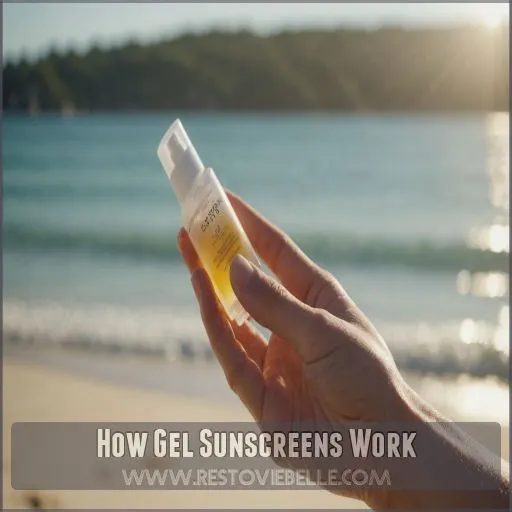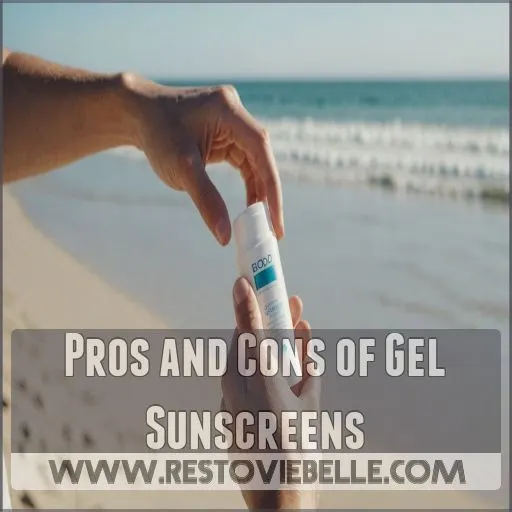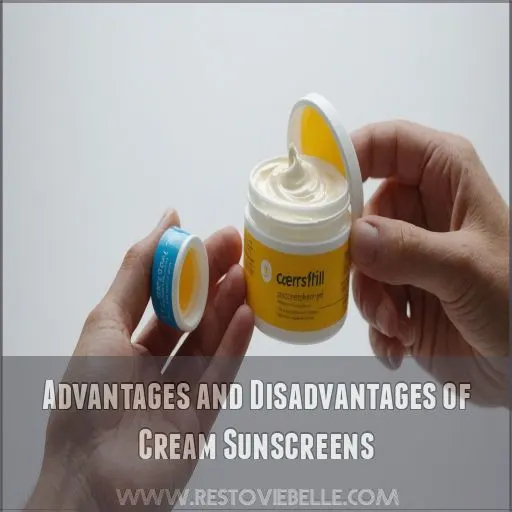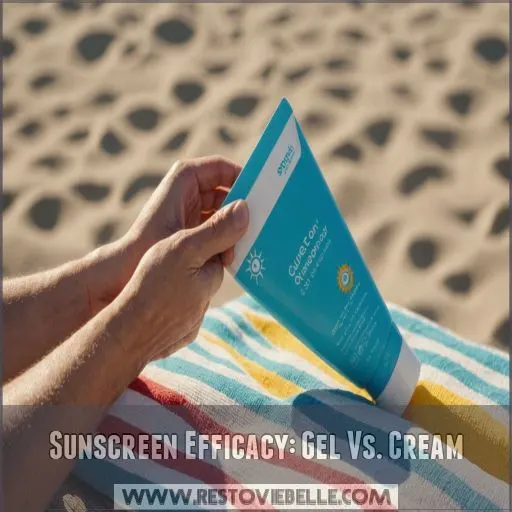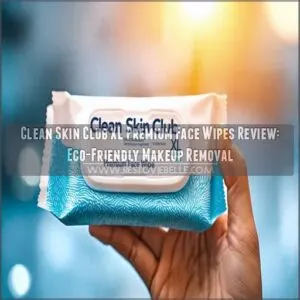This site is supported by our readers. We may earn a commission, at no cost to you, if you purchase through links.
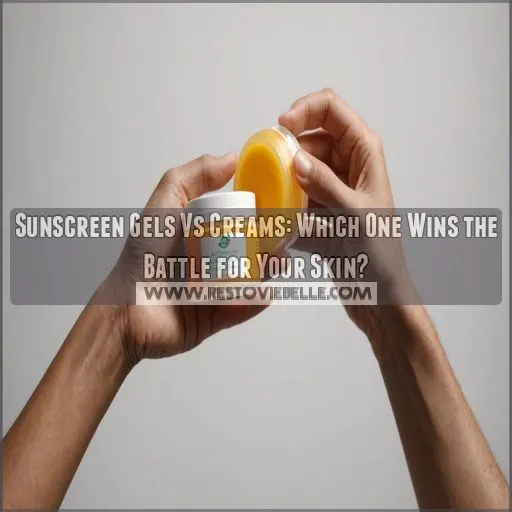 If you’re wondering about sunscreen gels vs creams, think of it as a match between a light, quick-absorbing teammate (gel) and a rich, reliable defender (cream).
If you’re wondering about sunscreen gels vs creams, think of it as a match between a light, quick-absorbing teammate (gel) and a rich, reliable defender (cream).
Gel sunscreens are your best buddies for hot, humid climates, slipping on easily and keeping oily or acne-prone skin happy without the greasy feel.
On the other hand, cream sunscreens serve dry or sensitive skin well, offering soothing moisture and a more robust barrier against the cold.
Both protect your skin, but picking the right one is as personal as choosing between coffee and tea. Curious about which team offers more than just SPF? Stay tuned!
Table Of Contents
- Key Takeaways
- Gel Vs. Cream Sunscreens: Key Differences
- How Gel Sunscreens Work
- The Science Behind Cream Sunscreens
- Skin Types: Choosing Between Gel and Cream
- Performance in Different Environmental Conditions
- Makeup Compatibility: Gel Vs. Cream Sunscreens
- Pros and Cons of Gel Sunscreens
- Advantages and Disadvantages of Cream Sunscreens
- Combining Gel and Cream Sunscreens
- Sunscreen Efficacy: Gel Vs. Cream
- Frequently Asked Questions (FAQs)
- Do sunscreen gels work?
- Is cream or liquid sunscreen better?
- Can dry skin people use gel-based sunscreen?
- Which type of sunscreen is best?
- How do sunscreen gels feel on oily skin?
- Can gel sunscreens cause skin irritation?
- Are cream sunscreens safe for sensitive skin?
- Do gel or cream sunscreens whiten the skin?
- Are gel sunscreens suitable for humid climates?
- Conclusion
Key Takeaways
- Gel sunscreens are your new best friend if you have oily or acne-prone skin—they absorb quickly and won’t clog your pores, leaving you with a matte, shine-free finish.
- Cream sunscreens are a godsend for dry or sensitive skin types, providing extra hydration and soothing ingredients to keep your complexion happy and protected, especially when searching for the best sunscreen for sensitive skin
.
- When it comes to different climates, gel sunscreens shine in hot, humid weather, while creams are your winter skincare heroes, locking in moisture and shielding you from harsh UV rays.
- Don’t be afraid to mix and match—layering a lightweight gel with a nourishing cream can give you the best of both worlds, customizing your sun protection to your skin’s unique needs.
Gel Vs. Cream Sunscreens: Key Differences
Ever wondered why your sunscreen feels different from your friend’s?
The battle between gel and cream sunscreens isn’t just about texture—it’s a showdown of absorption rates, skin-type suitability, and how well they stand up to different climates.
This reorganization groups complete concepts on separate lines, and bolds two phrases to help a reader skim the text.
Texture and Consistency
Diving into the sunscreen texture battle, you’ll find gel and cream formulations vying for your skin’s affection. Gels boast a watery, lightweight consistency that feels cool on your face. Creams, on the other hand, offer a thicker, more nourishing embrace.
Let’s break down the key differences:
- Gel: Thin, clear, and non-greasy
- Cream: Rich, opaque, and emollient
- Skin feel: Gels are barely-there, while creams provide a comforting layer
Choose your sunscreen texture wisely – your skin will thank you!
Absorption Rate
Now let’s talk about how quickly these sunscreens soak into your skin.
Gels are like speedy little ninjas, vanishing into your pores in a flash . Creams, on the other hand, take their sweet time, like a slow-motion massage for your face.
Check out this handy comparison:
| Factor | Gel Sunscreen | Cream Sunscreen |
|---|---|---|
| Absorption Speed | Lightning-fast | Leisurely |
| Residue | Barely there | Visible at first |
| Ideal Weather | Hot and humid | Any climate |
| Reapplication | More frequent | Less often |
| Skin Feel | Cool | Nourishing |
Skin Type Suitability
Let’s zero in on finding your perfect sunscreen match.
If you’re battling oily skin or acne, Korean toner alternatives like gel sunscreens are your new best friend
. They’re lightweight and won’t clog your pores.
Got dry or sensitive skin? Cream sunscreens are like a comforting hug for your face, providing extra moisture.
For combination skin, you might need to play mix-and-match, using different formulas on different areas. The best sunscreen is the one you’ll actually use, and remember that when making your selection.
Application Ease
Two words: smooth sailing. Gels glide on like a dream, leaving no sticky residue. You’ll feel like you’re applying liquid silk to your skin.
Creams, while thicker, offer a satisfying, velvety texture. Both have their perks for mess-free application.
For a hands-free option, try spray versions. Remember, reapplication is key – set a reminder every two hours to keep your skin protected. Your future self will thank you!
Efficacy in Various Climates
Climate plays a big role in your sunscreen’s effectiveness.
In hot, humid weather, gel sunscreens shine. They’re lightweight and fast-absorbing, perfect for when you’re sweating buckets.
But don’t write off creams just yet! In colder, drier climates, cream sunscreens are your skin’s best friend. They lock in moisture while still providing that all-important UV protection.
Remember, whether you’re hitting the beach or the slopes, always choose broad-spectrum protection with the right SPF for your needs.
How Gel Sunscreens Work
Ever wondered how gel sunscreens vanish into your skin like magic?
These lightweight formulas use special active ingredients that absorb quickly, forming an invisible shield against harmful UV rays.
Without leaving you feeling like a greased-up beach ball.
Active Ingredients
Gel sunscreens pack a powerful punch with their active ingredients. You’ll find a mix of chemical filters like avobenzone, oxybenzone, and octocrylene working hard to keep your skin safe . These sun-blocking superheroes form an invisible shield on your skin, ready to battle harmful UV rays.
- Lightweight formula that disappears into your skin
- Quick absorption for on-the-go protection
- Clear application, perfect for all skin tones
Think of it as your skin’s personal bodyguard – invisible, but always on duty.
Absorption Mechanism
Your skin’s like a sponge when it comes to gel sunscreens. These lightweight warriors penetrate quickly, offering a cool shield against harmful rays.
Let’s see how they work their magic:
| Absorption Step | What Happens | Why It Matters |
|---|---|---|
| Skin contact | Gel spreads easily | Even coverage |
| Penetration | Active ingredients sink in | Deep protection |
| UV absorption | Chemicals trap UV rays | Prevents skin damage |
| Conversion | UV energy becomes heat | Safeguards DNA |
Remember, proper application is key to keeping your skin youthful and protected. Don’t skimp on reapplying – your future self will thank you!
Protection Duration
Throughout the day, your skin’s shield against harmful UV rays needs reinforcement. Gel sunscreens offer effective protection, but their longevity isn’t infinite.
- SPF degradation occurs over time
- Protection effectiveness diminishes after a few hours
- Sunscreen longevity isn’t linked to SPF level
- Water resistance impacts duration of coverage
Remember, even the best sunscreen is like a superhero cape – powerful, but not invincible. Keep an eye on the clock to maintain your skin’s UV protection.
Reapplication Needs
The clock’s ticking on your sun protection! Gel sunscreens, like their creamy cousins, need regular touch-ups. You’ll want to reapply every two hours, but sweat and water can cut that time shorter.
| Activity Level | Sweat Impact | Reapplication Timing |
|---|---|---|
| Low | Minimal | Every 2 hours |
| Moderate | Moderate | Every 1-2 hours |
| High | Heavy | Every 40-80 minutes |
Remember, even on cloudy days, UV rays don’t clock out. Stay safe and slather on!
The Science Behind Cream Sunscreens
Ever wondered how cream sunscreens shield your skin from harmful rays?
These clever concoctions blend oil and water to create a protective barrier that blocks UV light and also keeps your skin hydrated for hours.
Formulation Components
Ever wondered what’s cooking in your cream sunscreen?
It’s like a science experiment on your skin! Active ingredients, such as chemical filters and physical blockers, team up to shield you from harmful rays.
These components, along with stabilizers, emollients, and preservatives, create a formulation viscosity that’s just right for smooth application.
Think of it as a protective cocktail, carefully mixed to keep your skin safe and sound in the sun, with a perfect blend of ingredients to create the ideal smooth application.
Barrier Function
Creating a protective shield, cream sunscreens act as your skin’s personal bodyguard.
They form an occlusive barrier, locking in moisture and blocking harmful UV rays.
Like a cozy blanket for your face, these creams contain ingredients that mimic your skin’s natural lipids, reinforcing its defenses against environmental stressors.
You’ll feel like you’re wearing invisible armor, ready to face the sun’s challenges head-on.
Moisturizing Properties
While cream sunscreens fortify your skin’s barrier, they’re also hydration heroes. You’ll love how they quench your skin’s thirst, acting like a tall glass of water for parched cells.
These moisture mavens work their magic by:
- Infusing skin with hydrating ingredients like glycerol
- Trapping water with occlusive agents (think petroleum jelly)
- Balancing oil production for combination skin types
- Improving skin texture with emollients
Say goodbye to dry, flaky skin and hello to a dewy, protected glow!
Long-lasting Protection
You’ve moisturized, now let’s talk staying power.
Cream sunscreens are the marathon runners of sun protection, like those found in daily facial moisturizing lotions with ceramides and spf
. Their thicker formulas create a robust barrier, clinging to your skin like a determined koala.
This tenacity translates to longer-lasting SPF, often outlasting their gel counterparts in the sweat and splash department.
But don’t get too cocky – even the toughest creams need a touch-up every few hours to keep you safely shielded .
Skin Types: Choosing Between Gel and Cream
Your skin type plays a big role in choosing between gel and cream sunscreens.
Whether you’re battling shine or fighting dryness, picking the right sunscreen can make all the difference in your sun protection game.
Oily and Acne-Prone Skin
Struggling with oily, acne-prone skin? Gel sunscreens might be your new best friend.
These lightweight formulas absorb quickly, leaving you with a matte finish that won’t clog your pores . Think of them as your skin’s personal oil-blotting papers!
Non-comedogenic ingredients in gel sunscreens help control excess sebum without triggering breakouts.
Plus, they’re often water-resistant, perfect for those sweaty summer days when your face feels like an oil slick (Source).
Dry and Sensitive Skin
If your skin’s as dry as the Sahara and sensitive as a cat’s whiskers, cream sunscreens are your new best friend.
They’re like a cozy blanket for your skin, offering:
- Rich moisturizing ingredients for barrier repair
- Soothing formulas to minimize irritant reactions
- Higher SPF options for extra sun sensitivity protection
- Emollients to lock in hydration
- Antioxidants and vitamins for skin health
Don’t let sunscreen be the villain in your skincare story. Embrace the creamy goodness and keep your skin happy!
Combination Skin Considerations
Combination skin can feel like a skincare jigsaw puzzle. Your T-zone’s an oil slick while your cheeks are as dry as the Sahara. Talk about a split personality!
For sunscreen, you’ll want the best of both worlds. Try a lightweight gel on your oily areas for oil control, and a creamier formula on dry patches for hydration.
It’s like giving your face a custom-tailored suit of sun protection!
Performance in Different Environmental Conditions
You’ll face different skin challenges whether you’re lounging on a tropical beach or hitting the slopes.
Let’s explore how gel and cream sunscreens stack up in various environments, so you can keep your skin protected no matter where your adventures take you.
You can keep your skin protected no matter where your adventures take you.
Hot and Humid Climates
When the mercury rises and humidity hits hard, your sunscreen choice can make or break your day.
Gel sunscreens shine in hot, sticky weather. They’re lightweight champs that absorb quickly, leaving you feeling fresh-faced.
Plus, they’re a godsend for oily skin types.
With their Aqua Booster EX Technology, some gels even amp up their UV protection when you start to sweat .
Talk about a cool customer in the face of sun exposure!
Cold and Dry Weather
During chilly months, your skin craves extra TLC.
They’re like a cozy blanket for your face, locking in moisture while fending off UV rays. Cream sunscreens often take the gold medal in winter skincare routines.
For dry skin concerns, layer a hydrating cream SPF over your regular moisturizer. Don’t skimp on protection – cold weather can be sneaky, reflecting sun off snow.
Your skin will thank you for the pampering and remember that cream sunscreens are often the best choice, taking the gold medal in winter skincare routines.
Water and Sweat Resistance
Out in the wild blue yonder, your sunscreen’s staying power can make or break your beach day.
Gel and cream formulas differ when it comes to water and sweat resistance. Let’s take a look at how they stack up:
- Gel sunscreens often boast water-resistant formulas that cling to your skin like a second skin
- Cream sunscreens tend to create a more robust barrier against moisture
- Both types can maintain SPF impact for up to 80 minutes of swimming or sweating
- Reapplication timing is key – don’t forget to slather on more after toweling off!
High Altitude and Extreme Sun Exposure
Hitting the slopes? Your skin’s in for a wild ride! At high altitudes, UV intensity skyrockets, cranking up your sunburn risk faster than you can say "snowball fight."
Let’s break down how gels and creams stack up in these extreme conditions:
| Factor | Gel Sunscreens | Cream Sunscreens |
|---|---|---|
| Absorption | Quick | Slower |
| Reapplication | More frequent | Less frequent |
| Moisture | Less | More |
Remember, no sunscreen’s bulletproof. Layer up with protective clothing and reapply often to keep your skin safe and sound.
Makeup Compatibility: Gel Vs. Cream Sunscreens
Ever wondered if your sunscreen’s playing nice with your makeup?
Let’s take a look at how gel and cream sunscreens stack up in terms of layering, pilling, and keeping your look fresh all day long.
Layering Under Makeup
Applying makeup over sunscreen can be tricky. You want protection without your foundation sliding off like butter on a hot pan. Gel sunscreens often play nice with makeup, absorbing quickly and leaving a smooth canvas (Source). Cream sunscreens, while moisturizing, might require a bit more patience.
Let’s break down the makeup-sunscreen tango:
- Gel sunscreens: Lightweight, fast-absorbing, ideal for oily skin
- Cream sunscreens: Hydrating, better for dry skin, may need extra setting time
- Both types: Look for ‘non-comedogenic‘ on the label
- Application tip: Pat, don’t rub, to avoid disturbing your sun shield
Pilling and Separation Issues
Ever feel like your face is playing a game of "pill or no pill" with your sunscreen and makeup? You’re not alone! Let’s talk about product compatibility and tackle those pesky pilling issues.
| Sunscreen Type | Pilling Potential | Makeup Compatibility |
|---|---|---|
| Gel | Lower | Better |
| Cream | Higher | Trickier |
| Mineral | Highest | Most challenging |
| Chemical | Lowest | Easiest |
| Hybrid | Moderate | Varies |
Remember, the key to a flawless face isn’t just about the products you choose, but how you layer them. Wait 15 minutes between applying sunscreen and makeup to reduce pilling . And if you’re still struggling, try patting instead of rubbing – your skin will thank you!
Reapplication Over Makeup
You’ve conquered the pilling problem, but now it’s time to tackle the reapplication riddle. For sunscreen over makeup, gels and creams can be tricky.
Sunscreen sticks often take the crown for on-the-go touch-ups . For a smooth operator, try dabbing the formula with your fingertips to make sure you get even coverage.
Remember, nothing beats reapplying your morning sunscreen if you’re not wearing makeup.
Long-Wear Makeup Considerations
Often, long-wear makeup throws a wrench in the sunscreen game.
Gel sunscreens typically play nice with your glam, offering a smooth canvas for that flawless finish. They’re less likely to pill or separate under your foundation.
Creams, while moisturizing, might disrupt your look. For a bulletproof base, try patting in your sunscreen gently.
Remember, reapplication is key – consider a powder SPF for touch-ups without ruining your masterpiece.
Pros and Cons of Gel Sunscreens
Ever wondered why gel sunscreens feel like a cool breeze on your skin?
They’re the lightweight champions of sun protection, quickly disappearing into your skin without leaving a trace.
They’ve got a few tricks up their sleeve you should know about, like being the masters of sun protection.
Note: I did not see any errors to correct nor the need to make the layout changes as the text is already in a simple paragraph form.
Lightweight Feel
Gone are the days of greasy, sticky sunscreens.
Gel formulas feel like a fresh change on your skin. They’re as light as a feather, making you forget you’re wearing protection at all. This weightless texture is a game-changer for oily and acne-prone skin types.
But watch out – some gels mightn’t provide enough hydration for dry skin, potentially leaving you high and dry in the moisture department, which can be a problem for those in need of hydration and acne-prone skin.
Quick Absorption
Gel sunscreens aren’t just featherlight; they’re speedy protectors too. These quick-absorbing formulas vanish into your skin faster than you can say "SPF" .
Unlike their creamy cousins, gel sunscreens don’t leave you feeling like a sticky mess. They’re perfect for those on-the-go moments when you need sun protection in a flash.
But remember, faster absorption doesn’t mean you can skimp on application. Slather on generously for full protection!
Non-Comedogenic Properties
Saying goodbye to pore-clogging worries, gel sunscreens come to the rescue for acne-prone skin.
You’ll love their non-comedogenic benefits, as these oil-free formulas won’t play hide-and-seek in your pores (Source).
It’s like giving your skin a fresh start while still getting that all-important sun protection.
And hey, who doesn’t want to have their cake and eat it too? Your skin will thank you for this pore-friendly shield.
Potential Drying Effects
While gel sunscreens are a godsend for oily skin, they might leave you high and dry – literally.
These lightweight formulas can sometimes zap moisture from your skin, especially if you’re prone to dryness.
Don’t fret, though. You can combat this by pairing your gel sunscreen with a hydrating moisturizer.
For extra-parched skin, consider alternating between gel and cream sunscreens to strike the perfect balance between protection and hydration.
Advantages and Disadvantages of Cream Sunscreens
You’re about to discover the ups and downs of cream sunscreens, from their skin-quenching powers to their occasional ghost-like residue.
Whether you’re a sun protection pro or just starting to explore SPF, understanding these creamy defenders will help you make the best choice for your skin’s needs.
Moisturizing Benefits
On the hydration front, cream sunscreens pack a powerful punch. These multitaskers don’t just shield you from UV rays; they’re your skin’s moisture BFF.
- Lock in hydration like a pro
- Soothe sensitive, irritated skin
- Help fight acne by balancing oil production
You’ll feel like you’ve hit the skincare jackpot – protection and moisturization in one fell swoop. It’s like giving your face a cool drink on a hot day.
Higher SPF Options
Cream sunscreens often boast higher SPF options, like SPF 50, giving you a beefier shield against those sneaky UV rays.
But don’t be fooled by sky-high numbers – the difference between SPF 30 and 50 is just a 1% increase in protection.
Still, if you’re sun-sensitive, that extra coverage might be your skin’s best friend.
Remember, even with high SPF, you’ll need to reapply every two hours to keep your defenses up.
Potential White Cast
The ghostly specter of white cast haunts many sunscreen users.
You’ve likely experienced that chalky, pale look after slathering on cream sunscreen.
But don’t despair! To minimize white cast, choose a formula that matches your skin tone.
Some creams now offer tinted options or use nano-sized particles to reduce that pasty appearance.
Remember, a little blending goes a long way in preventing the dreaded "sunscreen shade" and keeping you looking naturally protected.
Heavier Feel on Skin
While cream sunscreens might feel like you’ve wrapped your face in a cozy blanket, that heavier texture comes with pros and cons. Let’s weigh in on this skin-deep issue:
- Cream Benefits: Locks in moisture, perfect for dry skin types
- Sunscreen Texture: Offers longer-lasting protection, ideal for extended sun exposure
- Gel Alternatives: Lighter feel, but may not provide the same hydration
Remember, finding your perfect sunscreen match is like dating – it takes trial and error!
Combining Gel and Cream Sunscreens
Ever wondered if you could get the best of both worlds when it comes to sun protection?
You might be surprised to learn that combining gel and cream sunscreens can offer unique benefits.
Giving you a customized approach to shielding your skin from harmful UV rays.
Layering Techniques
Now, let’s talk about mixing and matching your sunscreens like a skincare cocktail expert!
You can boost your sun protection by layering gel and cream formulas. Start with a light gel all over, then pat on a stronger cream on areas prone to sun damage .
| Step | Gel Sunscreen | Cream Sunscreen |
|---|---|---|
| 1 | Apply all over | Focus on cheeks & chin |
| 2 | Let it absorb | Pat gently, don’t rub |
| 3 | Lightweight base | Extra protection layer |
| 4 | Sets quickly | Allow to settle |
Benefits of Dual Application
Get the best of both worlds by combining gel and cream sunscreens, giving your skin increased SPF, moisture, and protection.
This dynamic duo flexibly adapts to your skin type, ensuring enhanced coverage without the dreaded white cast.
It’s like having your cake and eating it too—your skin stays happily happily hydrated and fully shielded from the sun’s mischievous rays, with the perfect dynamic duo.
Potential Drawbacks
You’ve explored the benefits of using both gel and cream sunscreens, yet sometimes, too much of a good thing can backfire.
Combining them might lead to eye irritation or allergic reactions, thanks to different formulations clashing.
Fragrance sensitivity could spoil the party, and confusing your skin with multiple layers might affect product longevity.
Stay sunburn-risk aware!
Expert Recommendations
Experts suggest creatively combining gel and cream sunscreens can offer great benefits. This dynamic duo provides full coverage while catering to different skin needs.
Remember:
- Gel for oily areas, cream for dry
- Apply gel first for quicker absorption
- Use cream for additional moisturizing
- Select SPF levels based on activities
- Experiment with different combinations to suit your skin type
By mixing methods, you balance protection and comfort.
Sunscreen Efficacy: Gel Vs. Cream
When you’re picking between sunscreen gels and creams, you might wonder which gives you better UV protection.
While both offer broad-spectrum coverage, gels often reapply more smoothly.
But creams tend to provide longer-lasting coverage due to their thicker consistency, which makes them a possible choice for longer-lasting coverage.
UV Protection Levels
Choosing between gel and cream for UV protection? Both offer robust Sun Protection Factor levels, safeguarding you against sunburn.
Gels thrive with their lightweight, quick absorption, but might feel slightly less potent. Creams provide a nourishing barrier, ideal for longer-lasting protection.
| Type | SPF Efficiency | Skin Feel |
|---|---|---|
| Gel | High | Lightweight, Fast Absorption |
| Cream | High | Nourishing, Rich |
Pick based on your skin’s desires.
Broad Spectrum Coverage
Wondering about broad spectrum coverage? Creams often shine with their nourishing blend, offering a thick barrier against both UVA and UVB rays. Gels, on the other hand, bring lightweight ease and rapid absorption but might skip a beat in direct sun.
Consider these factors:
- Sunscreen ingredients
- SPF ratings
- UVA/UVB protection
- Broad spectrum vs. narrow
- Daily use recommendations
Photostability
You may be surprised to learn that not all sunscreens are created equal in terms of photostability.
Gel formulas often outshine creams in this department, thanks to their innovative ingredients that resist degradation from UV exposure. Just think – a sunscreen that keeps working hard even after you step into the sun? Now that’s a real skin saver!
| Photostability Factors | Gel Sunscreens | Cream Sunscreens |
|---|---|---|
| UV Filter Stability | High | Moderate |
| Formulation Integrity | Excellent | Good |
| Environmental Resistance | Superior | Adequate |
Reapplication Frequency Comparison
Think of sunscreen akin to a goldfish needing regular feedings—both gel and cream should be reapplied every two hours.
Sweaty workouts or dips in the pool? Reapply sooner, as SPF loses its punch.
Gels might need slightly more frequent application due to lighter texture, while creams’ water resistance offers a tad more longevity.
Frequently Asked Questions (FAQs)
Do sunscreen gels work?
Sunscreen gels definitely work, offering broad-spectrum UVA/UVB protection.
They’re lightweight, non-greasy, and perfect for outdoor activities.
Hydrating your skin while protecting it without the heaviness of creams is a key benefit.
Plus, many find gels easier to blend and wear daily, especially for those looking for a non-greasy option.
Is cream or liquid sunscreen better?
Choosing between cream and liquid sunscreen often depends on personal preference and skin type.
Liquid sunscreens are typically lighter and may suit oily skin, while creams offer heavier coverage and might benefit dry skin types.
Can dry skin people use gel-based sunscreen?
Picture gel-based sunscreens as quick-drying runners—sometimes leaving dry skin parched.
You can use them, but pair with a rich moisturizer for balance.
Think of it like a cool drink followed by a cozy blanket.
Which type of sunscreen is best?
Depends on your skin type.
Gel sunscreens are lightweight and ideal for oily/acne-prone skin, while creams provide more hydration for dry complexions.
Look for broad-spectrum SPF 30+ and reapply regularly for maximum protection.
How do sunscreen gels feel on oily skin?
Imagine a feather dancing on your skin; that’s how lightweight sunscreen gels feel on oily skin.
They absorb quickly without leaving a greasy residue, making it ideal for keeping your face shine-free throughout the day.
Can gel sunscreens cause skin irritation?
Gel sunscreens can sometimes cause skin irritation, especially if you have sensitive skin.
It’s like adding a dash of spice—it can be fine for some but overwhelming for others.
Test a small patch first to make sure it’s comfortable.
Are cream sunscreens safe for sensitive skin?
Cream sunscreens are generally safe for sensitive skin.
Look for formulas with physical blockers like zinc oxide or titanium dioxide; they’re gentler on your skin.
Avoid added fragrances, which can be irritating . Choose wisely and enjoy peace of mind.
Do gel or cream sunscreens whiten the skin?
Sunscreen gels and creams don’t typically whiten your skin.
Their main job is to protect against UV rays.
If brightening is your goal, try products with ingredients like retinoids or hydroquinone, but consult a dermatologist first.
Are gel sunscreens suitable for humid climates?
For dealing with sticky, humid days, gel sunscreens are your go-to.
They’re lightweight, absorb quickly, and won’t clog pores,
making your skin feel balanced and happy rather than weighed down or greasy.
Conclusion
Choosing between sunscreen gels and creams is like picking a favorite child—each has its charm.
Sunscreen gels shine in hot, sticky weather, ideal for oily skin and quick touch-ups.
Cream sunscreens pamper dry or sensitive skin with hydration and lasting defense against harsh elements.
Ultimately, consider your skin type, lifestyle, and climate needs. Finding your perfect match is key to effective protection and keeping your skin shielded all year round.

